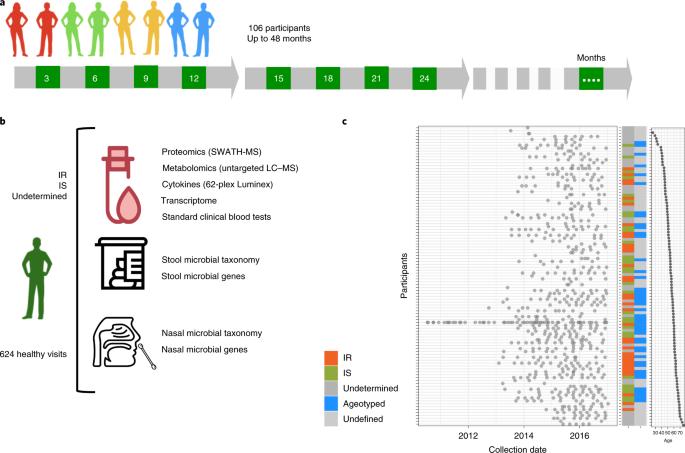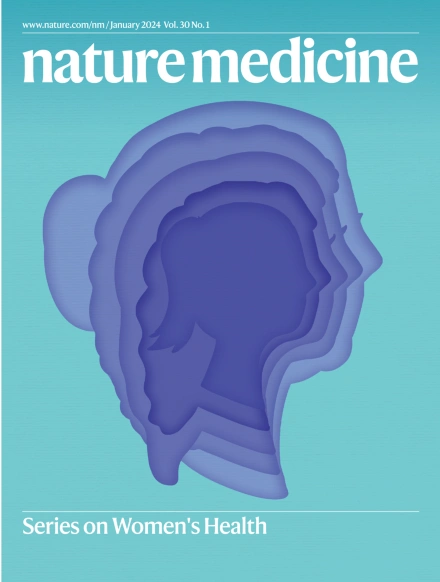Personal aging markers and ageotypes revealed by deep longitudinal profiling
IF 50
1区 医学
Q1 BIOCHEMISTRY & MOLECULAR BIOLOGY
引用次数: 171
Abstract
The molecular changes that occur with aging are not well understood1–4. Here, we performed longitudinal and deep multiomics profiling of 106 healthy individuals from 29 to 75 years of age and examined how different types of ‘omic’ measurements, including transcripts, proteins, metabolites, cytokines, microbes and clinical laboratory values, correlate with age. We identified both known and new markers that associated with age, as well as distinct molecular patterns of aging in insulin-resistant as compared to insulin-sensitive individuals. In a longitudinal setting, we identified personal aging markers whose levels changed over a short time frame of 2–3 years. Further, we defined different types of aging patterns in different individuals, termed ‘ageotypes’, on the basis of the types of molecular pathways that changed over time in a given individual. Ageotypes may provide a molecular assessment of personal aging, reflective of personal lifestyle and medical history, that may ultimately be useful in monitoring and intervening in the aging process. Longitudinal multiomics profiling of a cohort of healthy people reveals distinct aging patterns—termed ageotypes—in different individuals.

深度纵向剖析揭示的个人衰老标记和年龄类型
人们对随着年龄增长而发生的分子变化还不甚了解1-4。在这里,我们对 106 名 29 至 75 岁的健康人进行了纵向和深度多组学分析,研究了不同类型的 "omic "测量(包括转录物、蛋白质、代谢物、细胞因子、微生物和临床实验室值)与年龄的相关性。我们发现了与年龄相关的已知标记物和新标记物,以及与胰岛素敏感人群相比,胰岛素抵抗人群衰老的不同分子模式。在纵向环境中,我们确定了在 2-3 年的短时间内其水平会发生变化的个人衰老标志物。此外,我们还根据特定个体随时间变化的分子通路类型,定义了不同个体的不同类型衰老模式,称为 "年龄类型"。年龄类型可提供个人衰老的分子评估,反映个人生活方式和病史,最终可能有助于监测和干预衰老过程。对一批健康人进行的纵向多组学分析揭示了不同个体的独特衰老模式--即年龄型。
本文章由计算机程序翻译,如有差异,请以英文原文为准。
求助全文
约1分钟内获得全文
求助全文
来源期刊

Nature Medicine
医学-生化与分子生物学
CiteScore
100.90
自引率
0.70%
发文量
525
审稿时长
1 months
期刊介绍:
Nature Medicine is a monthly journal publishing original peer-reviewed research in all areas of medicine. The publication focuses on originality, timeliness, interdisciplinary interest, and the impact on improving human health. In addition to research articles, Nature Medicine also publishes commissioned content such as News, Reviews, and Perspectives. This content aims to provide context for the latest advances in translational and clinical research, reaching a wide audience of M.D. and Ph.D. readers. All editorial decisions for the journal are made by a team of full-time professional editors.
Nature Medicine consider all types of clinical research, including:
-Case-reports and small case series
-Clinical trials, whether phase 1, 2, 3 or 4
-Observational studies
-Meta-analyses
-Biomarker studies
-Public and global health studies
Nature Medicine is also committed to facilitating communication between translational and clinical researchers. As such, we consider “hybrid” studies with preclinical and translational findings reported alongside data from clinical studies.
 求助内容:
求助内容: 应助结果提醒方式:
应助结果提醒方式:


